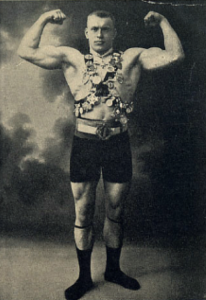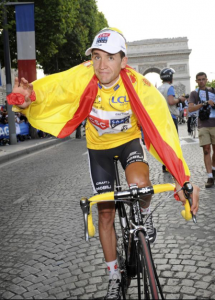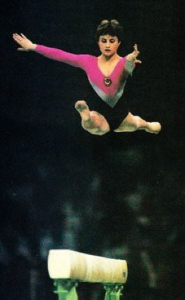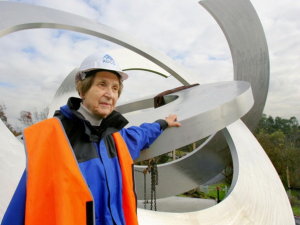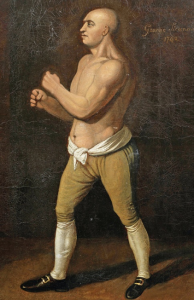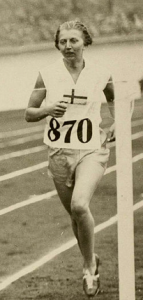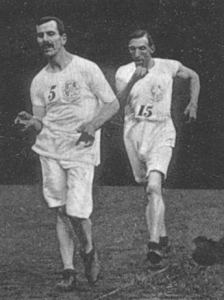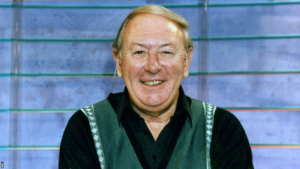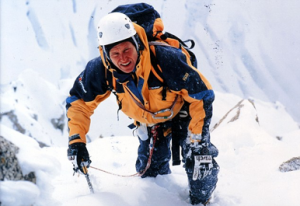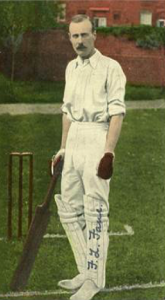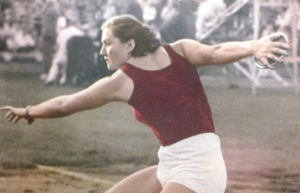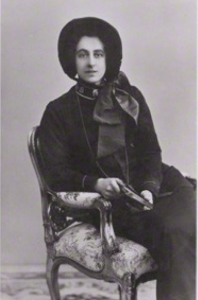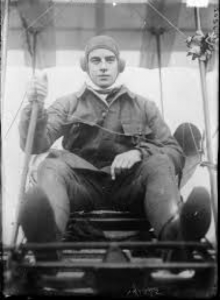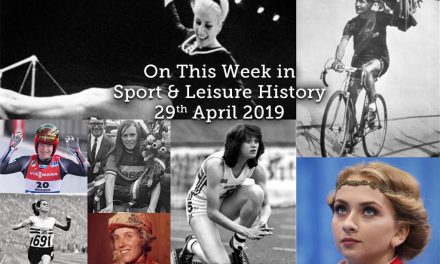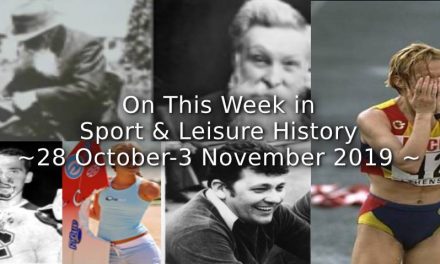22nd
- Georg Lurich, Estonian Greco-Roman wrestler and strongman of the early 20th century was born in 1876. Lurich was also the trainer of Estonian wrestlers and weightlifters Georg Hackenschmidt and Aleksander Aberg. After graduating from Peter’s Modern School in Tallinn in 1895, he travelled to St. Petersburg, Russia where he practised weightlifting and wrestling under the supervision of the athletics coach Dr. Wladyslaw Krajewski. Lurich performed in St. Petersburg’s summer gardens, competed with local wrestlers and made various lifting demonstrations together with fellow strongman Gustav Boesberg. His popularity convinced him to follow a career in as a professional athlete. Lurich became the first Estonian to set world weightlifting records. The Estonian public eagerly attended his matches and Lurich’s popularity in his homeland soared. From 1897 to 1898 Lurich toured Estonia and his successes helped popularize athletics in Estonia and dozens of athletic clubs were established. In 1896, Lurich befriended an 18-year-old fellow countryman by the name of Georg Hackenschmidt and began to train the young man. Hackenschmidt would later go on to create a name for himself in weightlifting and wrestling. Lurich’s popularity in Estonia also helped galvanize the move toward Estonian independence and instilled a sense of nationalist pride among the people. Estonia was at that time a part of tsarist Russia, and many higher ranking Estonian officials and intellectuals touted Lurich’s accomplishments as proof of the “unbreakable Estonian spirit”. Prior to World War I, Lurich, along with friend and fellow Estonian wrestler Aleksander Aberg travelled to the United States to perform for American audiences. Lurich performed in free-style wrestling matches in the United States between 1913 and 1917. He wrestled American world wrestling champion and title holder Frank Gotch in Kansas City in 1913, but lost what would be Gotch’s final match. After returning home via Japan, China and Russia in 1917 they arrived in Estonia in the autumn. They participated in a wrestling tournament in the capital city of Tallinn that remained unfinished due to the approach of German troops. The two athletes went to Saint Petersburg and on to southern Russia. The Russian Civil War meant an end to work in Saint Petersburg and Moscow. Conditions seemed better in the southern region, which was controlled by the White Army. However, the war spread and the men had to flee further inside Russia. They were halted in a far corner of southern Russia in a village called Armavir and the two men would become stranded in the village. Their initial aim was to leave Russia across the Black Sea by boat. Things took a dramatic turn in Armavir at the beginning of 1920. The front reached them, the town passed from hand to hand in battles several times and many civilians perished. A warm winter brought about an epidemic of typhoid fever and due to the continuing war, medical aid was difficult to obtain. Lurich fell ill first and could not be rescued, dying on January 20, 1920. Aberg had also become infected with typhus, but managed to defeat the illness. Aberg rushed his recovery, caught pneumonia, and died on February 15, 1920. The wrestlers were buried in one grave in Armavir German cemetery.
- Today in 1906 the 1906 Summer Olympics, not now recognised as part of the official Olympic Games, opened in Athens. The Games were an international multi-sport event and were at the time considered to be Olympic Games and were referred to as the “Second International Olympic Games in Athens” by the International Olympic Committee. Whilst medals were distributed to the participants during these games, they are not officially recognised by the IOC today and not displayed with the collection of Olympic medals at the Olympic Museum in Lausanne, Switzerland. French prima ballerina and actress Yvette Chauviré was born in 1917, she is often described as France’s greatest ballerina, and was the coach of prima ballerinas Sylvie Guillem and Marie-Claude Pietragalla. She was awarded the Légion d’Honneur in 1964.
- Australian tycoon Alan Bond was bond in 1938. He was the man who masterminded Australia’s win in the America’s Cup in 1983.
- The All-Black great of the late 197s and early 1980s Dave Loveridge was born in 1952. Loveridge grew up during the golden age of Taranaki rugby, with the provincial side holding the Ranfurly Shield in 1957–1959, and 1963–1965. Loveridge played age-group representative rugby for Taranaki at the age of 12. He worked for a bank after leaving school, and in 1972 the bank transferred him to Auckland. While in Auckland Loveridge was selected for the Auckland University club team, and soon caught the eye of the provincial selectors. He played two games for Auckland, but after a 34-3 loss to North Auckland, in which he was marking All Black veteran Sid Going, Loveridge was discarded from the team.In 1974 Loveridge married and returned to Tariki to run the family farm, where he played for Inglewood seniors and secured the halfback position in the Taranaki team. The following year he was selected for the Junior All Blacks, and in 1977 was given his first All Black trial. In 1978 he was reserve All Black halfback for the three-match series against the Wallabies, but didn’t get on the field. He finally got the chance to don the black jersey in the tour to Great Britain at the end of the year, and on October 21, 1978, made his debut against Cardiff at The Arms Park He played his first test match when first-choice halfback Mark Donaldson was stung with an ankle injury and ruled out of the match against Wales. While New Zealand almost lost that match, only winning because of Andy Haden’s famed lineout dive, Loveridge played a competent game. Donaldson remained first choice for the home season of 1979, but Loveridge finally gained the edge and secured the test matches against England and Scotland at the end of the year.Loveridge went on to play 54 matches for the All Blacks, 24 of which were tests. In 1980 Mourie and Dalton were unavailable for the tour of Australia, and Loveridge was selected as captain. Loveridge was most renowned for his performance in the second test against the touring British Lions on 18 June 1983, at Athletic Park in Wellington. In 1984 Loveridge suffered a serious knee injury, which hampered his game for the rest of his career. Loveridge joined the New Zealand Cavaliers for the rebel tour of South Africa in 1986, which proved to be his final appearance in the black jersey. He retired from New Zealand first class rugby at the end of that year, at the age of 34, after 54 matches for the All Blacks and 136 games for Taranaki.
- On this day in 1959 the Crystal Place goal-keeper Vic Rouse became the first fourth division player to win an international cap. The occasion was not auspicious, however, he conceded four goals in Wales’s 4-1 defeat by Northern Ireland at Belfast.
- Magnús Ver Magnússon, Icelandic powerlifter and strongman was born on this day in 1963. He has won the title of World’s Strongest Man four times (1991, 1994, 1995, and 1996). Magnús began powerlifting in 1984, and in 1985 he won a medal in the junior European and World Championships. He won the Senior European title in the 125kg (276 lb) class in 1988 and 1990. Magnús competed in his first strongman contest in 1985, finishing third in the Iceland’s Strongest Man competition won by Jón Páll Sigmarsson. He decided to focus solely on strongman competition after he won the 1991 World’s Strongest Man contest. His strongman victories include the 1989 Pure Strength contest in Scotland, the 1991 and 1993 International Power Challenge, the 1992 Scandinavian Strongest Man (Finland), the 1992 Nordic Strongest Man (Denmark), the 1994 Europe’s Strongest Man, the 1995 World Muscle Power Championship, and the 1995 and 1997 Viking Challenge. He is considered to be one of the first modern strongman competitors, and is regarded by many to be one of the best strongmen of all time. He carried Jón Páll’s formula of being athletic for the dynamic tests of strength and having tremendous static strength to out lift some of the best Powerlifters. Magnús owns a powerlifting and strongman gym in Reykjavík called Jakaból (Nest Of Giants). The name Jakaból is a reference to an old gym in Reykjavík where Jón Páll Sigmarsson and many other Icelandic legends used to train.
- In 1969 the British yachtsman Sir Robin Knox-Johnson wins the Sunday Times Golden Globe Race and completes the first solo non-stop circumnavigation of the world.
- Carlos Sastre Candil, Spanish road cyclist, winner of the 2008 Tour de France, also known as Carlos Sastre was born in 1975. He consistently achieved great results in the Vuelta a España and equally good showings in the Tour de France. Sastre established himself as a strong and stable climbing specialist, and after working to improve his individual time trial skills, he became a contender for the top GC spots in the Grand Tours. In total, Sastre finished in the top ten overall of fifteen Grand Tours during his career. Sastre rode for UCI Professional Continental team Saunier Duval–Prodir in 2011, before retiring. Sastre continues to be widely regarded, following the Lance Armstrong affair, as one of the very few ‘clean’ riders to have won the Tour de France in modern times as he has never been involved in a doping affair.All of this, though, appears to mean little to Sastre: “The fact that I finished my career without being involved in a doping scandal didn’t make me happy or proud,” he says. “I feel happy because I had a successful career, I have a great family and I’m the same person as I was before. Even after nearly 20 years as a pro, I still love cycling...” When he retired at the end of 2011, the cycling world barely batted an eyelid. A few months later,ProCycling met Sastre to ask whether recent events will prompt a re-assessment of his legacy. “Nothing is easy in life. Maybe I’m wrong. Maybe I took the wrong way and maybe that’s why nobody recognised me afterwards. I’m not a judge: I don’t know whether I took the right path and someone else the wrong one. But at the time I never wasted my time thinking about whether I was doing the right thing. I did it at the start of my career and I wasted energy but I eventually learned how I could get through with my training and hard work and still get satisfaction.”
- Today in 2014 the American, Meb Keflezighi won the Boston Marathon, one year after the race was targeted by bombers, an American last won the men’s race in 1983.
- Georg Lurich
- Carlos Sastre
23rd
- On this day in 1879 fire burns down the second main building and dome of the University of Notre Dame,which prompts the construction of the third, and current, Main Building with its golden dome.
- The British conductor and composer Albert Coates was born in 1882. Born in Saint Petersburg where his English father was a successful businessman, he studied in Russia, England and Germany, before beginning his career as a conductor in a series of German opera houses. He was a success in England conducting Wagner at the Royal Opera House, Covent Garden in 1914, and in 1919 was appointed chief conductor of the London Symphony Orchestra. His strengths as a conductor lay in opera and the Russian repertoire, and he was not thought as impressive in the core Austro-German symphonic repertoire. After 1923 he failed to secure a permanent conductorship in the UK, and for much of the rest of his life he guest conducted in continental Europe and the US. In his last years he took orchestral appointments in South Africa, where he died at 71. As a composer, Coates is little remembered, but he composed seven operas, one of which was performed at Covent Garden. He also wrote some concert works for orchestral forces. In its obituary of Coates, The Times wrote that his compositions “fell between the two stools of national character and international sympathy, with a resulting ambiguity of achievement.” The Grove Dictionary of Music and Musicians describes them as “technically proficient rather than imaginative”. His works include the operas Samuel Pepys and Pickwick; the former was given in German in Munich in 1929, and the latter in English at Covent Garden in 1936. His five other operas included The Myth Beautiful (1920). His concert works included a piano concerto and a symphonic poem The Eagle, dedicated to the memory of his former teacher Nikisch, which was performed in Leeds in 1925. Albert Coates was married in 1910 to Ella Holland. They had one daughter, Tamara Sydonie Coates, who became a professional oboist. Coates’ grandchildren include violinist Elizabeth Wallfisch. His great-grandchildren include composer Benjamin Wallfisch. By marriage to Holland, Coates was John Stott’s uncle.
- Folke Janson, Swedish triple-jumper, was born today in 1897. He won seven Swedish triple jump titles, in 1917 and 1919–24, and held the Swedish record from 1918 to 1931; in 1921 he also won the Amateur Athletic Association of England championships.
- In 1914 the first baseball game at Wrigley Field, then known as Weeghman Park, in Chicago takes place.
- Jim Fixx the American who authored the 1977 best-selling book The Complete Book of Running and thereby credited with helping start America’s fitness revolution, popularizing the sport of running and demonstrating the health benefits of regular jogging, was born in 1932. Fixx was a member of the high-IQ club, Mensa, and published three collections of puzzles: Games for the Super-Intelligent, More Games for the Super-Intelligent, and Solve It! The back flap of his first book says: “… He spent his time running on the roads and trails near his home, training for the Boston Marathon.” Fixx started running in 1967 at age 35. He weighed 214 pounds (97kg) and smoked two packs of cigarettes per day. Ten years later, when his book, The Complete Book of Running (which spent 11 weeks at No 1 on the best-seller list) was published, he was 60 pounds (27kg) lighter and smoke-free. In his books and on television talk shows, he extolled the benefits of physical exercise and how it considerably increased the average life expectancy. In 1980 Fixx wrote a follow-up book titled Jim Fixx’s Second Book of Running: The Companion Volume to The Complete Book of Running. In 1982 he published Jackpot!, the story of what happened after the publication of The Complete Book of Runninh when he experienced the “Great American Fame Machine”, becoming richer and more celebrated than he could have imagined. Ironically he died of a heart attack while jogging at 52 years of age; his father Calvin Fixx had died even younger of the same. His genetic predisposition for heart problems and other previous lifestyle factors may have caused his heart attack.
- English Cricketer David Mills was born in 1937, a right-handed batsman who bowled right-arm medium pace, he was born in Camborne, Cornwall and educated at Clifton College, where he represented the college cricket team. Mills made his only first-class appearance for Gloucestershire against Cambridge University in 1958. In his match, he scored 17 runs, before being dismissed by Michael James, in what was his only batting innings for the county. He later made a further first-class appearance in 1960, this time for the Free Foresters against Cambridge University. In this match, he once again batted once, scoring 2 runs before being dismissed by David Kirby.
- The career of racing driver Stirling Moss ended in 1962 when he crashed his Lotus-Climax at 110mph (177km/h) during a hard-fought F1 race at Goodwood on Easter Monday. Hampered by a faulty gearbox, Moss was pushing hard to get back on terms with the race leader, Graham Hill, when he lost control. He recovered from a broken leg, broken ribs and serious head injuries but never raced again in F1.
- The Russian World, European and Olympic champion gymnast Yelena Shushunova sometimes called Elena Shushunova was born on this day in 1969. Shushunova is one of was one of five women who have won the “Grand Slam” of all-around titles at all major competitions: Olympics, World Championships and European/Continental Championships and one of ten women who medaled on every event at World Championships. Shushunova was renowned for pioneering complex skills as well as for her explosive and dynamic tumbling and high consistency. Her career highlights as a junior gymnast include gold medals at the 1982 Moscow News (now known as Moscow Stars of the World) and the Junior European Championships. In 1983 she won the USSR Cup, which she won every year until 1988 with the exception of 1984. Shushunova was unable to compete at the 1984 Olympics, which were boycotted by the Soviet Union. Instead, she competed at the 1984 Friendship Games in Olomouc, Czechoslovakia, where she finished third all around and helped the USSR to win gold in the team event. Shushunova retired after the Olympics and currently lives in her hometown of Saint Petersburg, site of the 1998 European Championships which she helped organize. In 2004 she was inducted into the International Gymnastics Hall of Fame and in 2005 she was inducted into the International Jewish Sports Hall of Fame. Shushunova died from complications of pneumonia on 16 August 2018, aged 49.
- Tesfaye Jifar, born in 1976, is an Ethiopian long-distance runner. He won the New York City Marathon in 2001, his time of 2:07:43 stood as the course record for ten years. The same year he was second at the Tokyo Marathon and won the Saint Silvester Marathon held in Brazil. At the Amsterdam Marathon in 1999 he was second and broke the Ethiopian record held by Belayneh Dinsamo. Jifar’s time of 2:06:49 hours remains his personal best, he has also won three medals at the IAAF World Half Marathon Championships; bronze in 1999 and 2000 and silver in 2001.At the 2001 World Championships in Athletics in Edmonton he finished seventh in the Marathon.
- At the Crucible Theatre, Sheffield, in 1983 Canada’s Cliff Thorburn recorded the first maximum 147 break in the world professional championships during his match against Terry Griffiths.
- Former England cricketer Jim Laker died in 1986,aged 63. He will long be remembered for his bowling in the Test match at Old Trafford in 1956, when he took 19 Australian wickets for 90, 9 for 37 in the first innings and 10 for 53 in the second. No other bowler has taken more than seventeen wickets in a first-class match, let alone in a Test match. The feat is unique and, many think, may well remain so. Ten wickets in an innings, more than any other achievement in cricket, must contain a large element of luck: however well a man bowls, the odds must always be that his partner will pick up a wicket. In this case these odds were heavier than usual because Lock at the other end was, on such a wicket, as great a spinner as Laker and bowled superbly. What turned the scale was that Laker was bowling off-breaks whereas Lock relied on the left-armer’s natural leg-break, and the Australians at that period were wholly inexperienced in playing off-breaks, especially on a wicket which, heavily marled and almost devoid of grass, might have been designed for an off-spinner.
- Jaap Havekotte, Dutch speed skater, died in 2014 aged 102. He skated in several Dutch championships during the 1940s, but is best known as the founder of Viking Schaatsenfabriek, a Dutch producer of ice skates. The Viking ice skate proved to be very popular, and by 1972 every speed skating world record was skated on Viking ice skates. Viking was the first company to produce the clap skate on a large scale. Due to his significant influence on speed skating in the Netherlands, speed skaters from later generations spoke fondly of Havekotte and used to call him ‘Oom Jaap’ (‘Uncle Jaap’).
- Inge King née Neufeld, German born Australian sculptor, died at the age of 100, on this day in 2016. After her father’s death in 1930 the Neufeld family struggled financially. Inge was forced to take a position as a window dresser in a department store. After Hitler came to power, her mother and two older sisters emigrated – another sister died in the Holocaust – while Inge lived for periods in a Zionist commune and in lodgings where she worked as a home help. During this time she became increasingly interested in sculpture and took lessons in wood carving and clay modelling from the sculptor Hermann Nonnenmacher.In 1937 she enrolled at Vereinigten Staatsschulen (the Berlin Academy of Fine Arts), where she was one of only three non-Aryan students. She was forced out the following year and in 1939 she left Germany for Britain. In Britain she found work in domestic service and then, in 1940, was accepted into the Royal Academy. Her time at the RA was cut short by the Blitz and she transferred to Glasgow School of Art where she studied under the Estonian sculptor Benno Schotz. After the war she moved to the Abbey Art Centre, a community of artists based in New Barnet, Hertfordshire. There she met Grahame King, who was renowned for his work with photochromes and lithographs. In the late 1940s she had her first solo exhibition at the London Gallery in Mayfair. She and King married in 1950 and emigrated the following year, settling in Melbourne. Inge King compared her arrival to “opening a can of flat beer”. Having been exposed to the progressives of Weimar Germany, the Bauhaus and the British avant-garde, she found artistic circles in Australia to be “almost Victorian” by comparison. Although her early works bore a similarity to her British counterparts Henry Moore and Barbara Hepworth, her style moved on to monumental metal works that owed more to the Americans David Smith and Donald Judd. She created huge geometric steel sculptures, often painted black, that were as much architectural as they were artistic. They were, Inge King claimed, attempts at taming the continent’s rugged panoramas. She received many significant public commissions. Her work is held in public and private collections, the best known work of which, Forward Surge (1974), is housed at the Melbourne Arts Centre. She became a Member of the Order of Australia (AM) in January 1984. Her sculptures and contribution to the arts in this country and beyond are unquestionably significant. The sculpture ‘Rings of Saturn’ at Heide Museum of Modern Art shows she was an artist on high. It is one of Australia’s great sculptures and fabulously sited. Inge, was considered a liberated woman, a thinker of clarity and a massive achiever. The well-being of Australia’s culture was thought to be richer for her and she was said to be sadly missed by those that did and did not know her.
- Elena Shushunova
- Inge King
24th
- On this day in 1704 the first regular newspaper in British Colonial America, The Boston News-Letter, is published.
- In 1741 George Stevenson became the first fighter to lose his life as a direct result of a prize fight. He died after a bout with Jack Broughton at Taylor’s Booth, Tottenham Court Road.
- On this day in 1792 Claude-Joseph Rouget de Lisle composes “La Marseillaise”, it went on to become France’s national anthem.
- The United States Library of Congress is established today in 1800, when President John Adams signs legislation to appropriate $5,000 to purchase “such books as may be necessary for the use of Congress”.
- Sandy Herd, Scottish professional golfer was born in 1868. He was the club professional at Huddersfield Golf Club from 1892 to 1911. In 1902, he won The Open Championship at Hoylake. He had a three shot lead after 54 holes, but nearly let the title slip out of his hands by scoring an 81 in the final round. Harry Vardon and James Braid both had medium length putts at the final hole to force a play-off, but they missed and Herd took the Championship. He was the first Open Champion to use the Haskell rubber-cored ball. In 1920 he became the oldest runner-up in The Open before Tom Watson in 2009. Herd’s appearances in The Open Championship spanned fifty years, his last appearance being at St Andrews in 1939, when he was 71. On that occasion he failed to qualify for the tournament. Herd’s brother Fred won the 1898 US Open.
- In 1880 the Amateur Athletic Association, the then governing body for men’s athletics in England & Wales, was founded in Oxford. It is the oldest national governing body for athletics in the world; three men from Oxford University were responsible for its founding Clement Jackson, Montague Shearman and Bernhard Wise. The first AAA Championships were held on the 3 July 1880 at Lillie Bridge. Dame Marea Hartman was the first woman president of the AAA when she was appointed in 1991. The AAA of England was formed in 1991 following the merger of the previous AAA and the Women’s AAA (formed in 1922).
- In 1897 Batley beat St Helens 10-3 in front of 13,292 fans at Headingley, Leeds, to win the first Northern Union Cup (now the Rugby League Challenge Cup).
- Inga Gentzel, later Dahlgren, was born today in 1908. She was a Swedish runner, who won bronze in the 800m at the 1928 Olympics. Shortly before the Olympics she set a new world record in this event, which was broken two weeks later, but remained a national record until 1943. Gentzel won silver in the 1000m at the 1926 Women’s World Games. Gentzel held Swedish titles in the 200m in 1929 and in the 800m in 1928–31. She worked as a piano teacher in Nyköping and often appeared on the Swedish radio as a member of the vocal group Trio Rita, together with Ulla Castegren and Anna-Lisa Cronström.
- In 1916 Ernest Shackleton and five men of the Imperial Trans-Antarctic Expedition launch a lifeboat fromunihabited elephant Island in the Southern ocean to organise a rescue for the crew of the sunken Endurance.
- Tommy Docherty, the football manager reputed to have had more clubs that Jack Nicklaus was born on this day in 1928. In his playing days he was with Celtic and Preston North End, at the latter taking over the number 4 shirt from Bill Shankly. He enjoyed success as a manager at Chelsea and Manchester United, but also endured some failures, at Derby County and Wolverhampton Wanderers for example.
- Chorley’s Carl Crook beat Najib Daho of Manchester in 1991 to retain this British lightweight title. This victory gave him the Lonsdale Belt in a record 161 days, beating his previous record of 203 days held by Robert Dickie since 1986.
- Laura Kenny, née Trott; was born in 1992, she is a British track and road cyclist who specialises in the team pursuit, omnium and scratch race disciplines. With four Olympic gold medals, having won the team pursuit and the omnium at both the 2012 and 2016 games, Kenny is both the most successful female track cyclist in Olympic history (behind only Dutch track and road legend Leontien van Moorsel), and Great Britain’s most successful Olympic female competitor in any sport.
- Gary Lineker of Tottenham Hotspur received the Football Writers’ Footballer of the Year Award for the second time in 1992; he first won it in 1986, while at Everton.
- On this day in 2012 the organizers of the London Marathon accidentally publish the home and email addresses of 38,000 entrants in the marathon on their website.
- Tamio “Tommy“ Kono, American weightlifter in the 1950s and 1960s, died today in 2016. He set world records in four different weight classes: lightweight (149 pounds or 67.5 kilograms), middleweight (165 lb or 75 kg), light-heavyweight (182 lb or 82.5 kg), and middle-heavyweight (198 lb or 90 kg)
- George Stevenson
- Inga Gentzel
25th
- On this day in 1684 a patent is granted for the thimble. As long as 30,000 years ago early mastodon hunters were using the ivory tusks to create buttons by drilling holes through disks of the substance. They then used bone rings to protect hands while attaching the buttons to heavy leather garments. The miniature cup-shaped item that we call thimbles today first made an appearance in the Etruscan area of what is modern day Italy. About 2,500 years ago, as the Etruscans moved north into the area that is now Germany, they took their technology with them and it eventually spread across Europe. In the 15th century, most thimbles were made of copper and the metal would stain the cloth as one sewed. In Germany it was discovered that adding a special soil to the copper made a metal that was a beautiful colour and stain resistant. It also stank to high heaven! An industrious unnamed scientist figured out that the ingredient in the soil that made the difference was zinc. Copper and zinc make the alloy known as brass. The secret stayed in Nuremburg for 200 years where most of the European thimbles were made.
- Today in 1719 Daniel Defoe’s novel Robinson Crusoe was published.
- Charles Burgess Fry, known as CB Fry, English sportsman, politician, diplomat, academic, teacher, writer, editor and publisher, who is best remembered for his career as a cricketer was born in 1872. John Arlott described him with the words: “Charles Fry could be autocratic, angry and self-willed: he was also magnanimous, extravagant, generous, elegant, brilliant – and fun … he was probably the most variously gifted Englishman of any age.” Fry’s achievements on the sporting field included representing England at both cricket and football, an FA Cup Final appearance for Southampton F.C. and equalling the then-world record for the long jump. He also reputedly turned down the throne of Albania. In later life, he suffered mental health problems, but even well into his seventies he claimed he was still able to perform his party trick: leaping from a stationary position backwards onto a mantelpiece.
- Walter de la Mare (FYI my favourite poet) was born in 1873. He is probably best remembered for his works for children, for his poem “The Listeners”, and for a highly acclaimed selection of subtle psychological horror stories, amongst them “Seaton’s Aunt” and “All Hallows”. Preferred to be known as ‘Jack’ by his family and friends as he disliked the name Walter, he worked from 1890 in the statistics department of the London office of Standard Oil for eighteen years to support his family, but nevertheless found time to write. In 1908, through the efforts of Sir Henry Newbolt he received a Civil List pension which enabled him to concentrate on writing. For the Collected Stories for Children (Faber & Faber, 1947), he won the annual Carnegie Medal from the Library Association, recognising the year’s best children’s book by a British subject. It was the first collection to win the award. His ashes are buried in the crypt of St Paul’s Cathedral, where he had once been a choirboy.
- Ernie Webb, British race-walker, who competed for Herne Hill Harriers, was born in Hackney in 1874. Ernie went to sea aged 12 and then enlisted in the Army, where he saw active service in the Boer War. His walking prowess was first noticed at the Tobacco Trade Games and in 1906, aged 34 he joined Herne Hill Harriers, finishing 5th in the AAA 7 mile walk – winning the event the following year. This saw the beginning of an impressive record at the Championships: winning the 7 miles in 1908, the 2 and 7 miles in 1909 and 1920, and coming second in the 2 miles in 1908 and 1912. In 1909-10 he won the Harvey Memorial Cup for best Champion of the year. Ernie competed for Great Britain in the 1908 Olympics in the 10 mile walk where he won silver behind fellow Brit George Larner. The two of them repeated this in the 3500m walk giving Ernest Webb his second silver of the games. Four years later he returned to the 1912 Olympics in Stockholm where he competed in the inaugural 10k walk and finished off with his third Olympic silver behind Canada’s George Goulding. Ernie died on 24th February 1937, aged 62, following a fall from a ladder at his home in Toronto, Canada.
- Lia Manoliu, Romanian discus thrower who won a gold and two bronze Olympic medals and was the first track and field athlete to compete at six Olympics (1952–1972), was born in 1932. As a teenager Manoliu competed at the national level in tennis, table tennis, volleyball and basketball, before turning to throwing events at the age of 16. Two years later she became the first Romanian woman to throw the discus over 40m (41.44m, 22 May 1950). At the 1952 Olympics in Helsinki, she finished 6th with a throw of 42.64m. She bettered this distance in 1956 in Melbourne, throwing 43.90m for ninth-place. At the 1960 Olympics in Rome, she held the lead after the first round with a throw of 52.36m, and although she was unable to improve it, the throw was sufficient to earn her bronze. At the 1964 Olympics in Tokyo, Manoliu was outside the medals after round four, but then she produced a throw of 56.96m to win her a second Olympic bronze. In the winter of 1967–68, the Romanian Athletics Federation informed the 35-year-old Manoliu that she was too old to try for the Olympics again and that she need not bother turning out for their training camp sessions. This only increased her determination, and after months of individual training, she qualified for the Mexico City Olympics. There, she carried an arm injury, and the team doctor warned her that she would not last more than one good throw. Manoliu threw 58.28m on her first attempt, which proved good enough for the gold. On 19 July 1969, Manoliu won the UK national WAAA discus title at Crystal Palace, and in 1972, she finished 9th in the discus final at the 1972 Olympics with a throw of 58.50m. She retired shortly after the 1972 Games, and in 1974 was awarded the UNESCO Fair Play Prize, for her support to the ideals of fair and loyal competition. From 1973 and until her death Manoliu served as vice-president and then as president (since 1990) of the Romanian Olympic Committee. In 1975 she was awarded the Olympic Order in bronze and in 1994 the International Olympic Committee Centennial Trophy. She was a member of the IAAF Women’s Committee (1976–1995) and of the Romanian Senate in the 1990–1992 legislature. She died of a heart attack in January 1998 after lapsing into a coma during surgery for a brain tumour the week before. Until 2012 the national stadium in Bucharest was named after her.
- On this day in 1947 Lou Thesz beat Whipper Watson in St Louis to win the NBS world heavyweight title.
- The “Crafty Cockney”, professional Darts player Eric Bristow, was born in 1957. He won the game’s major titles, including a world record five world professional darts championships.
- On this day in 1964 Tranmere Rovers took only four seconds from the kick-off to score against Bradford Park Avenue, a League record. The goal was credited to Jim Fryatt, although the claim is often disputed because three other players touched the ball before it entered the net, thus making four seconds seem unlikely.
- British Paralympic swimmer Matt Walker was born in 1978, he has participated in four Paralympic Games, winning eleven medals, in the S7 (butterfly and freestyle), SM7 (medley) and SB7 (breaststroke) classifications. Walker’s first international medal came with a bronze in the 100m breaststroke at the 1997 European Championships in Spain. Since then he has gone on to win four further European Championship medals and eight World Championship medals. He also won bronze in the 50m freestyle and finished fourth in the 100m freestyle, at the 2006 Commonwealth Games in Melbourne, where he was the only disabled swimmer representing England. Beijing 2008 was Walker’s third appearance at a Paralympics, and his most successful to date with five medals won. He collected medals in both the 50 and 100m S7 freestyle events, as he had done in Athens, as well as in both the butterfly and medley events for the first time, winning silver in the 50m S7 butterfly, with a European record time of 32.24 seconds, and bronze in the 200m individual medley SM7. Competing alongside David Roberts, Robert Welbourn and Graham Edmunds, Walker won gold in the 4×100m freestyle 34 pts for the third time in as many Games. This meant that he has won eleven Paralympic medals, with all of his silver and bronze medals being won individually and all three golds being in relay events.
- Born on this day in 1981 was Swedish alpine skier Anja Pärson. She is an Olympic gold medalist, seven-time gold medalist at the World Championships, and two-time overall Alpine Skiing World Cup champion. She has won a total of 42 World Cup races. At the 2010 Winter Olympics, while trying to chase down eventual downhill champion Lindsey Vonn of the United States, Pärson lost her balance on the last jump before the finish, resulting in a 60-metre flight and subsequent fall, without however suffering serious injury. She recovered from the fall and one day later won bronze in the combined event. With a downhill victory in March 2011, she has won at least one race for ten consecutive World Cup seasons, trailing only Alberto Tomba and Vreni Schneider who won races in eleven consecutive World Cup seasons, and equalling the mark of Renate Götschl and Ingemar Stenmark. On 12 March 2012, Pärson officially announced her retirement, and that her last competition would be the World Cup final in Schladming the coming weekend. In 2014 she became an expert commentator for Viasat during the 2014 Olympics in Sochi.
- Michele Alboreto, Italian racing driver died today in 2001. He is famous for finishing runner up to Alain Prost in the1985 Formula One World Championship, as well as winning the 1997 Le Mans 24 Hours and 2001 12 Hours of Sebring car races. He also competed in Formula One from 1981 until 1994, racing for a number of teams, most notably his five seasons (1984–88) driving for Ferrari. The Italian’s career in motorsport began in 1976, racing a car he and a number of his friends had built in the Formula Monza series. The car, however, achieved very little success and two years later Alboreto moved up to Formula Three. Wins in the Italian Formula Three championship and a European Formula Three Championship crown in 1980 paved the way for the Italian’s entrance into Formula One with the Tyrrell team. Two wins, the first in the final round of the 1982 season in Las Vegas, and the second a year later in Detroit, earned him a place with the Ferrari team. Alboreto took three wins for the Italian team and challenged Alain Prost for the 1985 Championship, eventually losing out by 20 points. The following three seasons were less successful however and at the end of the 1988 campaign, the Italian left Ferrari and re-signed with his former employers Tyrrell, where he stayed until joining Larrousse mid-way through 1989. Further seasons with Footwork, Scuderia Italia and Minardi followed during the tail end of his F1 career. In 1995, Alboreto moved on to sports-cars and a year later the American IndyCar. In 2001, a month after his Sebring victory, he was killed testing an Audi R8 at the Lausitzring in Germany.
- Ernie Webb (15)
- Anja Pärson
26th
- German rower, Ernst Felle was born in 1876. He was part of the German boat Ludwigshafener Ruderverein, which won the bronze medal in the coxed fours final B at the 1900 Olympics.
- On this day in 1903 Atlético Madrid football club was founded.
- Fanny Blankers-Koen was born today in 1918. A Dutch athlete, best known for winning four gold medals at the 1948 Olympics in London. She accomplished this as a 30-year-old mother of two, during a time when many disregarded women’s athletics. Her background and performances earned her the nickname “the Flying Housewife”. She was the most successful athlete at the 1948 Summer Olympics. Having started competing in athletics in 1935, she took part in the 1936 Olympics a year later. Although international competition was eliminated by World War II, Blankers-Koen set several world records during that period, in events as diverse as the long jump, high jump, and sprint and hurdling events. Apart from her four Olympic titles, she won five European titles and 58 Dutch championships, and set or tied 12 world records – the last, pentathlon, in 1951 aged 33. She retired from athletics in 1955, after which she became captain of the Dutch female track and field team. In 1999, she was voted “Female Athlete of the Century” by the IAAF. Her Olympic victories are credited with helping to eliminate the belief that age and motherhood were a barrier to success in women’s sport. After her athletic career, Blankers-Koen served as the team leader of the Dutch athletics team, from the 1958 European Championships to the 1968 Summer Olympics. In 1977, her husband Jan died. It forced her, often dependent on Jan Blankers, to become more independent. Some years after his death, she moved back to her old hometown Hoofddorp. In 1981, the Fanny Blankers-Koen Games, an international athletics event, were established. They are still held annually in Hengelo. Fanny Blankers-Koen’s last moment of glory came in 1999. At a gala in Monaco, organized by the IAAF, she was declared the “Female Athlete of the Century”. She was very surprised to have won, audibly asking “You mean it is me who has won?” In the years prior to her death, she suffered from Alzheimer’s disease and lived in a psychiatric nursing home. She was also deaf. She died at age 85 in Hoofddorp on 25 January 2004. A year before her death, the first biography of Blankers-Koen was published, Een koningin met mannenbenen (A Queen with men’s legs) by journalist Kees Kooman. Through many interviews with relatives, friends and contemporary athletes, it paints a previously unknown picture of her. During her successful years, Dutch and international media portrayed her as the perfect mother (hence her nickname “The Flying Housewife”), who was very modest about her own achievements. Kooman’s book portrays Fanny Blankers-Koen in a different light, a woman who found it difficult to show affection and most of all always wanted to win. Blankers-Koen wrote an autobiography in 1949 with help from her husband.
- The 1924 FA Cup Final between Newcastle and Aston Villa was the first all ticket FA Cup Final.
- One of the BBC’s top commentators David Coleman was born on this day in 1929.
- Also on this day in 1929, the first non-stop flight from England to India was completed. Two Welshmen, Squadron Leader Arthur Jones-Williams and his co-pilot Flight Lieutenant Norman Jenkins, flying a Fairey Long-Range Monoplane – one of two built specifically for the RAF Long Range Development Unit set off from RAF Cranwell on 24 April. 50 hours and 38 minutes later they arrived at Karachi in the sub-continent.
- The Belgian middle-distance runner Roger Moens was born in 1930. In 1955 he broke Rudolf Harbig’s long-standing world record over 800m; at the 1960 Olympics in Rome he won silver in the 800m. On 3 August 1955, in the Bislett Stadium in Oslo, Moens improved Rudolf Harbig’s 16-year-old 800m world record of 1:46.6, running 1.45.7. He finished two-tenths of a second ahead of Norwegian Audun Boysen, who was also under the previous world record. Moens’ global record would stand for seven years, until it was improved in 1962 by New Zealander Peter Snell. As a Belgian record it stood for 20 years until broken in 1975 by Ivo Van Damme, who ran 1:45.31. On 8 August 1956, Moens along with his teammates set a world record in the 4×800m relay with a time of 7.15.8. Yet he did not go to the Melbourne Olympics, which took place in November. In training at night on a tennis court, he ran into a pole, injured himself, and, as world record holder and Olympic favourite, was forced to withdraw from the Games. At the Rome Games in 1960, Moens, aged 30 felt confident about the 800m, biding his time in the race, he followed the pack, waiting to unleash his final sprint in the straight, coming off the final turn Moens moved strongly into the lead and appeared to have the race won but Snell, a complete unknown at the time, passed him on the left shortly before the finish line. Snell won by inches in 1:46.3 to Moens’ 1:46.5. Immediately after the finish Moens threw himself on the grass and stayed there with his head in his hands. Years later, when asked whether the final in Rome still haunted him, he said, “Ah, it makes no sense to look back.” After retiring from competitions Moens served as a sports commentator for VRT; he interviewed his former rival Snell at the 1964 Olympics in Tokyo. A criminology graduate, he also worked for the Belgian judicial police, eventually becoming a commissioner general.
- British long-jumper Shirley Cawley was born in 1932. She won bronze in the long jump at the 1952 Olympics.
- Alan Hinkes was born in 1954, an English mountaineer from Northallerton in North Yorkshire, Hinkes is the first British mountaineer to have claimed all 14 mountains with elevations greater than 8,000m, the eight-thousanders; however, this claim is disputed. He is recorded as summiting Mount Everest in May 1996. He was awarded an Honorary Fellowship of the University of Sunderland in 1999, and an Honorary Doctorate from the University of York in 2007. In 2011, Hinkes teamed up with UK Tours Operator, Best of Britain Holidays, to lead their Three Peaks Challenge Tour.
- German freestyle skier Sandra Schmitt was born today in 1981. In 1998 she came 9th in the Women’s Moguls contest at the 1998 Winter Olympics in Nagano and the Women’s Dual Moguls World Champion in 1999. Schmitt died in the Kaprun disaster on 11 November 2000 aged 19. The Kaprun disaster was a fire that occurred in an ascending train in the tunnel of the Gletscherbahn Kaprun 2 funicular in Kaprun, Austria. The disaster claimed the lives of 155 people, leaving 12 survivors (10 Germans and two Austrians) from the burning train. The victims were all skiers on their way to the Kitzsteinhorn Glacier.
- Novlene Williams-Mills, née Novlene Williams, Jamaican track and field athlete was born in 1982. She won bronze in the 400m at the 2007 World Championships. She is also a three-time Olympic bronze medallist in the 4×400m relay. At the 2005 World Atheltics Championships she won (together with Shericka Williams, Ronetta Smith and Lorraine Fenton) silver and at the 2006 Commonwealth Games, she won bronze in the individual 400m. Williams attended the University of Florida, where she was a member of Coach Tom Jones’ Florida Gators track and field team. She graduated from the university with a bachelor’s degree in 2004. Novlene was born in Saint Ann, Jamaica. In July 2013, Williams-Mills told members of the media that she was diagnosed with breast cancer before the 2012 Olympics. Very few people at the time knew about the diagnosis. Despite the diagnosis, she still ran the race and was able to help Jamaica win a bronze medal. After the Olympics, Williams-Mills had a mastectomy and in January 2013 had another operation.
- British boxer Terry Spinks died on this day in 2012. He won the gold medal in the flyweight division at the 1956 Olympics in Melbourne; in the final he defeated Mircea Dobrescu of Romania on points. He was also British featherweight champion from 1960 to 1961.He was an apprentice jockey, before finding boxing more lucrative. Spinks had 49 professional bouts of which he won 41. He had his first professional bout in April 1957, against Jim Loughrey, at Harringay Arena, winning on a stoppage for a cut eye. In September 1960, Spinks fought for the British featherweight title, against the holder Bobby Neill. The fight was at the Royal Albert Hall, and Spinks won the title when the fight was stopped in the seventh due to cuts suffered by Neil. In November 1960, the two men had a re-match at the Empire Pool, Wembley. Spinks retained his new title by knocking Neill down three times in the fourteenth, with him finally being counted out. In May 1961, Spinks defended his title for the second time, against the Welshman, Howard Winstone. The fight was at the Empire Pool and Winstone won by a technical knockout in the tenth round. After losing his title, Spinks continued fighting, but never challenged for a title again. He had his last fight in December 1962 against Johnny Mantle, winning by a technical knockout in the eighth. After his boxing career ended Spinks became a trainer, coaching the South Korean team at the 1972 Olympics in Munich. He witnessed the Black September terrorists approaching the Israeli quarters before the Munich massacre and raised the alarm. Spinks died at his home in Essex after a long illness. More than 200 ex-boxers, including Bobby Neill and several more of Terry’s former opponents, attended his funeral in West Ham. Author and sports historian Norman Giller, his long-time friend, said in the eulogy: “Terry hung up his gloves in 1962 but we have never hung up our memories of one of the most accomplished fighters to come out of the East End boxing factory.”
- The 35th London Marathon, which was run on this day in 2015, was won by Kenyan Eliud Kipchoge & Ethiopian Tigist Tufa
- David Coleman
- Alan Hinkes
27th
- On this day in 1840 Edward Whymper, the first man to climb the Matterhorn was born.
- Maurice Raoul-Duval, French polo player, was born in 1866. In the 1900 Olympics he was part of the Bagatelle Polo Club de Paris team which won the bronze medal. He was also a member of the Compiègne Polo Club team which was eliminated in the first round of the same tournament. He was killed in action during World War I.
- English cricketer Frederick Luther Fanewas born today in 1875, he played cricket for the England cricket team in 14 Test matches. He also played for Essex, Oxford University and London County. Fane was born at Curragh Camp in County Kildare, Ireland, where his father Frederick John Fane, an officer in the British Army, was stationed with the 61st (South Gloucestershire) Regiment of Foot. He was a great-grandson of John Fane, a politician, of the family of the Earls of Westmorland. He was educated at Charterhouse School and Magdalen College, Oxford. Fane captained the England cricket team on five occasions: three times when he took over from the injured Arthur Jones, and twice when he took over from HDG Leveson Gower. He won two and lost three of these games. He was the first Irish born player to score a century in a Test match for England and remained the only one for over a hundred years, until Eoin Morgan repeated the feat against Pakistan at Trent Bridge in July 2010. During the First World War Fane was commissioned in the West Yorkshire Regiment. He was awarded the Military Cross in 1917 “for conspicuous gallantry and devotion to duty while commanding a patrol. Having obtained valuable information, he withdrew his men from a difficult position under heavy machine gun fire. He displayed the greatest coolness and determination.”
- The 4th Modern Olympic Games were opened in London today in 1908, a total of 2,036 athletes from 23 nations took part.
- Meanwhile at Stamford Bridge in 1908, Manchester United and Queen’s Park Rangers drew 1-1 in the first Charity Shield match. When the game was replayed four months later, United won 4-0.
- Luz Long, German Olympic long-jumper, notable for winning silver in the 1936 Olympics was born in 1913. He was also known for giving advice to Jessie Owens before the American went on to win the gold medal for the broad jump. Long won the German long jump championship six times in 1933, 1934, 1936, 1937, 1938, and 1939. He was killed in action serving in the German Army during World War II. For his actions in the spirit of sportsmanship, he was posthumously awarded the Pierre de Coubertin medal.
- Nina Ponomareva, a champion discus thrower who earned the Soviet Union its first Olympic gold medal when she competed in the 1952 Helsinki Games and touched off a diplomatic crisis four years later when she shoplifted five hats in a London store was born in 1929. Ponomareva, competing under her married name of Romashkova, led a strong women’s discus contingent when the Soviet Union made its first appearance in the Olympic Games. Already a national champion in the USSR, she took the gold with a throw of 168 feet 8 inches, shattering the Olympic record of 156-2 , set by Gisela Mauermayer at the 1936 Games in Berlin. Her teammates won the silver and bronze medals. Her win was an enormous coup for the Soviet Olympic team, regarded as little more than a joke at the time. Less than a month later, at a track meet in Odessa, she set a world record of 175-10½. Flawless on the field, Ponomareva took a bad step four years later in the millinery department of a store in London, where the Soviet track and field team had travelled to compete against a British team. Two store detectives at C&A Modes on Oxford Street testified that Ponomareva, who had attracted their attention by her furtive behaviour, had stuffed one hat in the sleeve of her coat and concealed four others between two paper bags that she was carrying. She was taken into custody, charged with theft of goods and ordered to appear in court the next day. Instead, she disappeared. “The Case of the Slipped Discus,” as one British newspaper called it, dominated headlines, giving the Suez Canal crisis a run for its money on the front page. The manager of the Soviet team, accusing the British of a “dirty provocation which was aimed at the blackmailing of this well-known and remarkable sportswoman,” pulled his athletes from the competition. A planned visit by the Bolshoi Ballet to Covent Garden looked to be in danger, as Galina Ulanova and other members of the troupe protested in a letter to the newspaper Izvestiya that they feared “persecution” if they made the trip. Ponomareva remained at large for more than a month, with a warrant out for her arrest. It was widely assumed that she was holed up in the Soviet Embassy, where an official dismissed the charges against her as absurd. “She has lots of money,” the official told reporters. “She could buy 100 hats.” She resurfaced to enter a not-guilty plea in Marlborough Street Magistrates Court. She had paid for the hats, she told the magistrate, but had not kept a receipt because such a thing did not exist in the Soviet Union. She was found guilty and, after paying a fine of three guineas and court costs, was set free. “The lady of the five hats,” as The Associated Press called her, was greeted enthusiastically by Australians when she stepped off the plane for the 1956 Olympic Games. Good-natured hecklers shouted, “Watch your hats, girls, here comes Nina.” She managed only a bronze medal — the scandal had disrupted her training — but she roared back at the 1960 Games in Rome to reclaim the gold. By then, her name was a byword in Britain. In a House of Commons debate on the lessons of the Suez crisis, the Labour member Tony Benn attacked as “banditry” the government’s foreign policy. “If the Canal is vital to us, we take it,” he said. “This is the morality of Nina Ponomareva — ‘I like your hat, I will have it.’” She died in 2016 aged 87.
- Heavyweight boxing championRocky Marciano retired undefeated on this day in 1956.
- Xerox PARC introduced the computer mouse on this day in 1981.
- Peter Scudamore became the first National Hunt jockey to ride 200 winners in a season in 1989 when he partnered Gay Moore to victory at Towcester. It was the first double century by a British jockey since Gordon Richards rode 200 on the flatin 1952.
- On this day in 1992 Betty Boothroyd became the first woman to be elected Speaker of the House of Commons in its 700-year history.
- On this day in 1993 a DHC-5D plane crashed into the Atlantic Ocean. The plane was heading out of Libreville, Gabon and was carring the Zambian national football team on their way to Dakar, Senegal to play a 1994 FIFA World Cup qualifying match against Senegal. The Zambian Air Force had specially arranged to fly the team and had three refuelling stops scheduled. The first was at Brazzaville, Congo and the second was here at Libreville. The de Havilland Canada DHC-5D Buffalo had taken off from Lusaka, Zambia and made the first refuelling stop without incident. At the stop, there was an issue with one of the engines but the flight continued on without delay. A few minutes after take-off from the second refuelling stop in Gabon, the left engine caught fire and failed. The pilot shut down the right engine which caused the plane to lose all power. The plane had still been in its climb and without power, fell into the water about 550 yards offshore. An investigation report issued ten years later attributed the accident to instrument error, pilot error and pilot fatigue. The same pilot had flown the team from a match in Mauritius the previous day. There had been 25 passengers and five crew on board and all of them were killed in the crash. The team, Chipolopolo, had been doing well and they were hoping to win the 1993 Africa Cup of Nations and make their first World Cup appearance. There were 18 players, the national team coach, and support staff aboard the plane. The captain of the Chipolopolo team, Kalusha Bwalya, was not aboard as he had been playing in the Netherlands for PSV and had made separate arrangements to get to Senegal. A new team was quickly put together in 1993 and Bwalya was faced with bringing them together to face off in the African Nations Cup, just a few months away. They made it to the finals, but were unable to defeat Nigeria in the last game. The team won the Africa Cup of Nations in 2012 in Libreville, only a short distance from where the plane had crashed nearly two decades earlier.
- Today in 2005 the Airbus A380 makes it first light from Toulouse, France.
- On this day in 2012 Barcelona’s football manager Josep Guardiola announced his resignation.
- Frederick Luther Fane
- Nina Ponomareva
28th
- Composer Lucy Milward Booth was born today in 1868, the eighth and youngest child of Catherine and William Booth, the Founder of The Salvation Army. At the age of 16, Lucy and her sister Emma went to India to work with The Salvation Army, Emma married Frederick Tucker in 1888. The Booth-Tuckers soon moved to London because of Emma’s failing health, and Lucy followed. On 18 October 1894 Lucy married Colonel Emanuel Daniel Hellberg, a Swedish Officer. As was the custom in the Booth family, the couple added ‘Booth’ to their married name, becoming Booth-Hellberg. Lucy wrote the song Keep On Believing for The Salvation Army. In 1909 her husband died. She went on to become the territorial commander for Denmark, Norway, and South America before she retired in 1934. In 1933 she was admitted to The Salvation Army’s most prestigious award, the Order of the Founder, “for long and exceptional service under peculiarly difficult circumstances, together with her readiness at all times to answer to the call of duty, particularly in the earlier years in India and France, and, latterly, in South America”. She died at Bromma in Stockholm on 18 July 1953, at the age of 85.
- The world’s first rugby sevens tournament was played on this day in 1883. Rugby sevens was initially conceived by Ned Haig a Jedburgh butcher who moved to Melrose and David Sanderson as a fund-raising event for a local club in 1883. The first ever sevens match was played at the Greenyards, the Melrose ground, where it was well received. Two years later, Tynedale was the first non-Scottish club to win one of the Borders Sevens titles at Gala in 1885. Despite sevens’ popularity in the Scottish Borders, it did not catch on elsewhere until after WWI, in the 1920s and 30s. The first sevens tournament outside Scotland was the Percy Park Sevens at North Shields in north east England in 1921. Because it was not far from the Scottish Borders, it attracted interest from the code’s birthplace, and the final was contested between Selkirk, who won and Melrose RFC, who didn’t! In 1926, England’s major tournament, the Middlesex Sevens was set up by Dr J.A. Russell-Cargill, a London-based Scot.
- Hyla Bristow Stallardknown as H B Stallard, the English middle-distance runner and ophthalmologist was born in 1901. Stallard was educated at Sherborne School before going up to Gonville and Caius College, Cambridge, where he studied medicine. At Caius he was a contemporary of Harold Abrahams, and a member of the University Athletics team in 1920, 1921 and 1922. He was part of the Oxbridge team that set a world record in the 4×880yd relay in 1922. Stallard competed at the 1924 Olympics where he won 1500m bronze and finished fourth in the 800m, despite sustaining a stress fracture in his right foot in the 1500m heats. Stallard is the only athlete that won the AAA titles over 440yds (1925), 880yds (1924), and mile (1923). He withdrew at the last minute from the 1926 AAA Championships after a copious blood donation to a patient at his hospital. Besides athletics, Stallard was a prominent doctor. As ophthalmic surgeon to St Bartholomew’s Hospital and Moorfields Eye Hospital, he pioneered cobalt plaque radiotherapy for the treatment of ocular tumours, particularly in children. He was elected as president of the Ophthalmological Society in 1972.
- The English pioneer of aviation, Claude Grahame-White was the first man to make a night flight, during the Daily Mail sponsored 1910 London to Manchester air race. Grahame-White was one of the first people to qualify as pilot in England, becoming the holder of Royal Aero Club certificate No. 6, awarded in April 1910. He became a celebrity in England when he competed with the French pilot Louis Paulhan for the £10,000 prize offered by the Daily Mail newspaper for the first flight between London and Manchester in less than 24 hours. Although Paulhan won the prize, Grahame White’s achievement was widely praised.
- Bolton Wanderers and West Ham United contested the first FA Cup Final at Wembley in 1923. Official receipts gave the attendance at 126,047 but it is estimated that more than 200,000 were in the ground. Bolton won 2-0 with David Jack having the honour of scoring the first goal.
- On this day in 1931 the programme for women athletes was approved for the 1932 Olympic track and field events.
- The 1966 Tour de Frane winner Lucien Aimar was born in 1941. He also won the national road championship in 1968. He is now a race organizer. He was born in Hyères, France.
- Former England Test cricket captain Mike Brearley was born in 1942. A great tactician and motivator, Brearley led Middlesex to four championships and two Gillette Cup victories between 1971-82. His record as England captain is phenomenal by present day standards; 18 Test wins out of a total of 31 played, with only four defeats.
- Clas Thunberg, Finnish speed skater who won five Olympic gold medals – three at the inaugural Winter Olympics held in Chamonix in 1924 (along with a silver and a bronze medal) and two at the 1928 Winter Olympics held in St. Moritz died on this day in 1973. He was the most successful athlete at both of these Winter Olympics, sharing the honour for 1928 Winter Olympics with Johan Grøttumsbraaten of Norway. Despite his amazing career record, Thunberg never reached the top of Adelskalender – a statistical invention which ranks skaters according to their personal bests and then converts them into all-round performances. Oscar Mathisen’s personal bests on the three longest distances were simply too good for Thunberg to match. However, Mathisen – who was born five years before Thunberg – turned professional during World War I, meaning that the two never met in an ISU-sanctioned event. He died in Helsinki at the age of 80.
- Wigan’s Andy Gregory became only the second Rugby League player to win the Lance Todd Trophy a second time. He was awarded this coveted laurel as man of the match for his contribution to Wigan’s triumph over Warrington in the 1990 Challenge Cup final at Wembley.
- Dennis Tito became the first space tourist on this day in 2001, paying £20 million to fly on a Soyuz mission to the ISS.
- Today in 2003 Andre Agassi recaptured the World number 1 ranking to become the oldest top-ranked male in the history of the ATP rankings; he was 33 years and 13 days old.
- Erhard Loretan Swiss mountain climber, often described as one of the greatest mountaineers of all times was born on this day in 1959 and died on his 52nd birthday in 2011. Loretan was born in Bulle in the canton of Fribourg. He trained as a cabinet-maker and mountain guide and began his climbing career at the age of 11. Loretan was the third person to have climbed all 14 eight-thousanders (second without oxygen), a feat he accomplished at the age of 36. He made his first expedition to the Andes in 1980 and began his conquest of the 8,000 metres (26,247ft) peaks in 1982 with the deadly Nanga Parbat. 13 years later, in 1995, he climbed the last of them, Kangchenjunga. In 1986, together with Jean Troillet, Loretan made a revolutionary ascent of Mount Everest in only 40 hours, climbing by night and without the use of supplementary oxygen. Loretan was convicted in 2003 of the manslaughter of his seven-month-old son, after shaking him for a short period of time to stop him crying in late 2001. He was given a four-month suspended sentence. At that time Shaken baby syndrome was largely unknown, but he decided to disclose his name to the press in the hope that other parents might avoid a similar drama. Publicity of the case raised awareness of the danger of shaking children due to weak neck muscles. In April 2011, Loretan and his partner Xenia Minder were undertaking the ascent of the Grünhorn when Minder slipped. The rope tying them together dragged them both down a 200m fall. Minder was airlifted to the hospital with serious injuries, but Loretan did not survive.
- Lucy Millward-Booth
- Claude Grahame White


